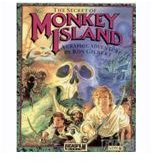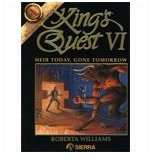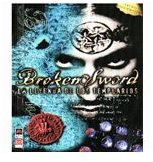The Ten Best PC Adventure Games

The Adventure Game
The adventure game was one of the first PC game genres, and holds an important place in video game history. These games helped encourage and spread the use of personal computers for gaming, and were a driving force behind many advancements in hardware and graphics. The heyday of adventure gaming was back in the early 1990s, before the genre was eclipsed by more complex and action-oriented genres such as first-person shooters and role-playing games.
But the adventure game has never truly gone away, remaining a niche genre throughout the late 1990s and early 2000s and seeing a small revival in recent years. It offers something entirely different from the games of today: character and story-driven experiences that are all about plot and ideas rather than combat and flashy graphics. Adventure games are linear and small-scale, the complete opposite of the huge and opened-ended RPG genre, so all they have to rely on is their stories and their imagined worlds.
And the best adventure games do this so well that you don’t mind having to complete everything in a predetermined order. A good adventure game is like a movie or novel, drawing you into a detailed and creative new universe and presenting you with mysteries to solve and puzzles to master. To play well you must use not your reflexes, but your intelligence, creativity, and patience. That’s exactly what these ten games are—the best and most immersive of the adventure games. Each one is an experience, whether funny or dark, that will stick with you long after the credits roll.
The Secret of Monkey Island (1990)
Though the oldest game on this list, The Secret of Monkey Island and its sequels remain very popular. In fact, LucasArts recently released a special edition of the game for PC and a number of other platforms. This swashbuckling pirate romp features romance, treasure, a ghost pirate, and a three-headed monkey, along with lots of laughs and comic situations. The puzzles can be tough but they aren’t impossible, and gameplay is smooth and very impressive for its time. The characters and situations are fun and engaging, the music is great, and for an adventure game Monkey Island is surprisingly non-linear. All-in-all, it’s not hard to see why this game (and its sequel, LeChuck’s Revenge) frequently pops up in ‘best PC games of all time’ lists, much less best pc adventure games lists.
Indiana Jones and the Fate of Atlantis (1992)
LucasArts ruled the adventure gaming world in the early 1990s, first with Monkey Island and then with this classic entry in the Indiana Jones saga. You play Indiana himself as he races to find the lost city of Atlantis before the Nazis. The most interesting feature of this game is its non-linearity (for an adventure game). There are three paths you can take through the adventure—focusing on action, puzzles, and teamwork respectively—and each features unique challenges and locations. This lends the game a fair amount of replay value, and gives you some customization over your experience. The puzzles are a good mix, easy to hard, and there is rarely just one way to solve them. You are rewarded by a point system for solving puzzles in unique ways, again lending replay value as you try to get a higher score each time around. Fate of Atlantis is one classic that shouldn’t be missed (you can find a playable version on the game download website Steam).
King’s Quest VI: Heir Today, Gone Tomorrow (1992)

The King’s Quest series by Sierra (one of the biggest names in adventure gaming) began with humble, text-oriented games and steadily improved until the sixth installment, generally considered the best of the series by far. In Heir Today, Gone Tomorrow you play as Prince Alexander, heir to the Kingdom of Daventry. A glimpse in a magic mirror shows Alexander a beautiful damsel-in-distress, and he runs off to find and rescue her. But though its roots are firmly in mythology and classic fairytales, King’s Quest VI stretches beyond those roots to offer a fully realized adventure with depth, detail, and realism. The puzzles are rewarding, the graphics were stunning for their time and are still charming, and there are even alternate endings. This game is a must for any fan of adventure gaming, whether or not you’ve played any of the other King’s Quest titles.
Myst (1993)
Developed by Cyan in 1993, Myst is the most famous (and in some ways infamous) adventure game of all time. There’s a lot of disagreement as to which of the five Myst games is actually the best, but it’s the original that deserves a place on this list for its central place in video game history. It was Myst that spurred the mass adoption of the CD-ROM, because it was a game everyone just had to have. With an original, engaging story line, lots of freedom to explore strange locales, and multiple endings, Myst is a surreal experience that in many ways has yet to be matched. Of course, a lot more people have started Myst than have actually finished it—this game is known for its lack of instructions, high level of difficulty, and sometimes frustratingly impossible puzzles. But with a little patience (and a walkthrough or two) it’s a perfectly playable game, and one that will stick with you long after it’s over.
Sam and Max Hit the Road (1993)

One of the quirkiest games on this list, Sam and Max Hit the Road was developed by LucasArts and is based on a franchise that began with a series of comic books in the 1980s. Sam and Max (a dog and a rabbit respectively) are a pair of freelance private investigators who exist in a cartoonish world that parodies many aspects of real-world American culture. The game, based around a case of a missing Bigfoot, is goofy, cheesy, colorful, and a whole lot of fun. It plays on typical detective and western stereotypes, and offers surprisingly intellectual humor. The puzzles are pretty standard, but the feel and look of the game are completely unique. And if you like what you get in Hit the Road, the franchise continues with a series of episodic games (Sam & Max Save the World).
Maniac Mansion: Day of the Tentacle (1993)
Released in the same year and by the same company (LucasArts), Day of the Tentacle has a lot in common with Sam and Max Hit the Road. It has a similar cartoonish style, quirky humor, and satirization of popular culture, but the situation is more futuristic and in some ways even more bizarre. A mad scientist creates a creature called the Purple Tentacle, which proceeds to evolve into a mischievous supervillan. Time travel, irony, and hilarity ensues as three mismatched heroes (a geek, a medical student, and a roadie) attempt to save the world. You get to play as all three characters, and find yourself in a whole lot of odd situations with equally odd solutions. The puzzles are inventory-based with no pixel hunting, and the dialogue is smart and well acted. The first Maniac Mansion game was a hit in 1987, but it’s this second installment that has earned its place as an adventure gaming classic.
Broken Sword: The Shadow of the Templars (1996)

Also known as Circle of Blood, Shadow of the Templars is the first in the Broken Sword series from British company Revolution Software. With a simple interface and straightforward gameplay, this game sticks to the most basic of adventuring gaming conventions and yet transcends them with a smart and very funny plot. You play as George Stobbart, an American tourist vacationing in Paris who gets pulled into an investigation featuring a clown-suited bomber and a centuries-old cult. There’s plenty of mystery, intrigue, and romance, as George travels to a variety of exotic locales and interacts with a number of memorable characters. The structure of Shadow of the Templars parodies crime noir flicks, and does so beautifully by rendering most of the dialogue and encounters into a narrative, crime-novel style. The darker, historical element perfectly complements this, and proves rather educational to boot. Of course, the puzzles are often too easy and don’t require a lot of thought or creativity. But it’s ok, because the story keeps you hooked and moving forward.
Grim Fandango (1998)
Yet another entry from LucasArts, Grim Fandango is consistently found at the top of best adventure games lists even though it didn’t do too well commercially (it was released just as the genre was loosing ground). Inspired by Mexican and Aztec folklore and beliefs, Grim Fandango takes place in a richly imagined and detailed world—or rather, after-world. You play as Manny Calavera, an employee at the Department of Death who helps speed newly departed souls on their way (while trying to work off his own sins so he can travel to the afterlife as well). There are plots, mysteries, intrigues, and a whole lot of very interesting characters, rendered in a bizarre but aesthetically pleasing style. The puzzles are balanced and worked believably into the plot, which in turn features surprising depth and intelligence. This is one of the most engaging adventures games, one that pulls you in with its atmosphere and creativity and doesn’t let go.
The Longest Journey (1999)

The Longest Journey, developed by Norweigan company Funcom, features one of the best and most detailed stories in adventure gaming. It also has one of the best female protagonists in the video game world: April Ryan, a spunky art student with charm, humor, and magical powers. April starts out on a futuristic world called Stark, but soon discovers a magical world called Arcadia that only she can somehow visit. Both words are compelling and filled with interesting locations, characters, and races, and you’ll spend time in each as April journeys to find out just what her role as a citizen of these two worlds is. In some ways the structure of the game follows the traditional fantasy adventure, but it manages to transcend clichés to become something deeper and more epic. The puzzles are well integrated if occasionally a bit illogical, and the scenery and animations are still nice to look at a decade later. The Longest Journey keeps you guessing until the very end, drawing you fully into its world until you don’t really want to leave (good thing there’s a sequel—Dreamfall: The Longest Journey).
Syberia (2002)
Though developed by Microids, Syberia is at heart the product of Belgian artist Benoit Sokal, who conceived and designed the plot and world. And as befitting a true artist, Syberia is a masterpiece. Set in a slightly altered version of our own world, the protagonist of this game is Kate Walker, another great female protagonist. Kate is an American lawyer, trying to close a buyout case in the sleepy French town Valadilene, but gets whisked up into a decades-old mystery that leads her to a variety of exotic places and memorable characters. You’ll get whisked right up with her, drawn in by the haunting, melancholic atmosphere and the strangeness of a world populated more by mechanical automatons than by people. The dialogue is excellent and sometimes hilarious, and the music is perfect. The puzzles are mainly inventory-based, and at a balanced level of difficulty (though at times requiring some frustrating pixel-hunting). Syberia is a game that is experienced, not played. And the end isn’t really the end—the second game in the series, Syberia II, is actually the second half of the game.
